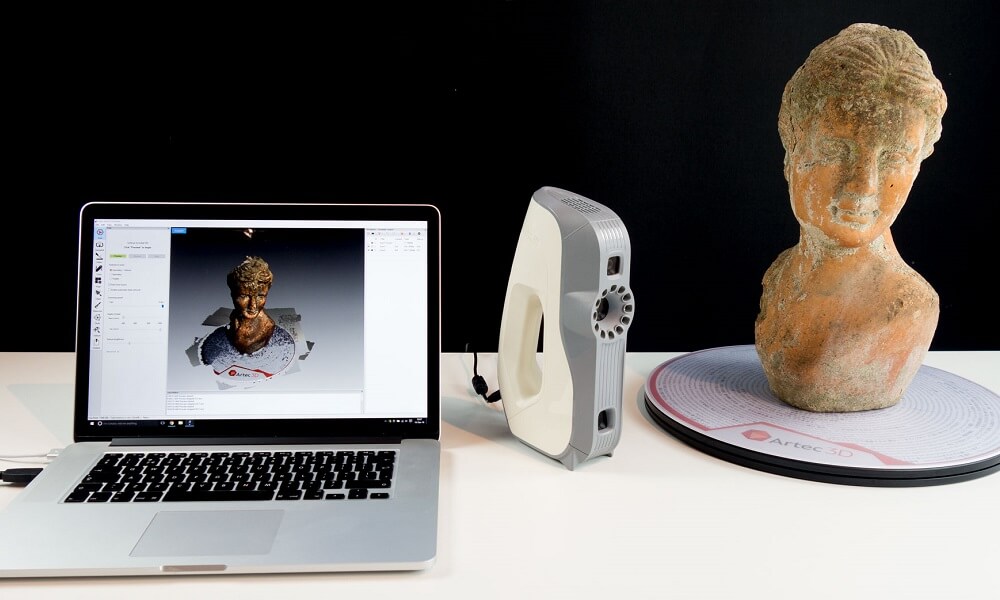To take greatest advantage of emerging digital retail opportunities, it’s necessary to create 3D photorealistic representations of physical products. They were a long time in coming, and now the enabling technologies have arrived. There are clear and compelling customer and brand benefits of converting a 2D catalog of photos to 3D models for use on a retail website, mobile app and other experiential contexts. This transformation creates a better/more engaging user experience, increased sales, a reduction of returns and shipping costs, as well as significant savings compared to traditional product photography.
Creating Your Models
There are three basic methods available: 3D scanning, photogrammetry, and making use of a professional 3D designer. As in all things, there are pros and cons to each that you’ll want to consider carefully before making your decision.
- 3D Scanning with Dedicated Equipment
This process uses light projected onto an object from various angles to capture highly accurate “point clouds,” which can then be used to reconstruct a 3D image. The scanner can measure fine details of the object, though does a better job on objects with distinct texture and that are matte, as opposed to smooth, shiny objects. 3D scanners are also sensitive to light — too much ambient light can distort the data — and so are best used indoors, in a room where lighting can be controlled. Since a 3D scanner has to interact with a real-world object, using one can be a good option for creating 3D models of products that already exist.

- Photogrammetry
In photogrammetry, a standard high-end digital camera is used to take photographs of an object from many angles and then specialized software stitches together the photos and detects overlapping patterns to create a 3D model of the photographed object. Technically, photogrammetry imitates the stereoscopy of the binocular human vision, using the various photograph angles to collect data regarding the shape, volume, and depth of the subject. Unlike with laser 3D scanning, you can photograph large objects out in the world, although professional 3D photogrammetry generally will happen in a controlled studio environment. In addition, all you need is a collection of existing photographs of an object to create the 3D model, not the actual object itself. Like laser 3D scanning, however, the software does not produce perfect models, so there is some manual tweaking involved before the 3D model is usable.
- Professional 3D Design
Let’s shift from photographic tools to human skills. A professional 3D designer uses a combination of skill and specialized 3D modeling software to create photorealistic 3D models using pictures along with product dimensions. Using a trained 3D designer to convert your 2D catalog to 3D models can speed time-to-market as the designer does not need access to the physical items and also requires only several images mentioned to “infer” how the object should look. In addition — and this is sometimes critical — the product doesn’t even have to exist yet; a designer can create 3D models based simply on digital prototypes.
A Comparison
| 3D Scanning | Photogrammetry | Professional 3D | |
| Interactive | YES | YES | YES |
| Efficient | YES | ||
| Affordable | YES | ||
| Accurate | YES | YES | |
| Animations | YES | YES | |
| Configurations | YES | YES | |
| Image Quality | YES | YES | |
| Performance | YES | YES | |
| Leverage Design | YES |
Our Solution
Real-time 3D is revolutionizing online retail, becoming a ‘must-have’ and no longer a ‘nice-to-have’ for your website. Now’s the time to take the plunge and convert 2D images to 3D models so you can upgrade the way customers experience your products and decide to purchase.
There are a number of ways to smoothly and efficiently accomplish the conversion of your catalog; the process can be straightforward and simple, especially if you choose to partner with 3D design experts. Unless you have a large, dedicated and trained team in place, outsourcing both the initial and ongoing processes will minimize the investment of time and money in 3D model preparation, and improve time to market.

